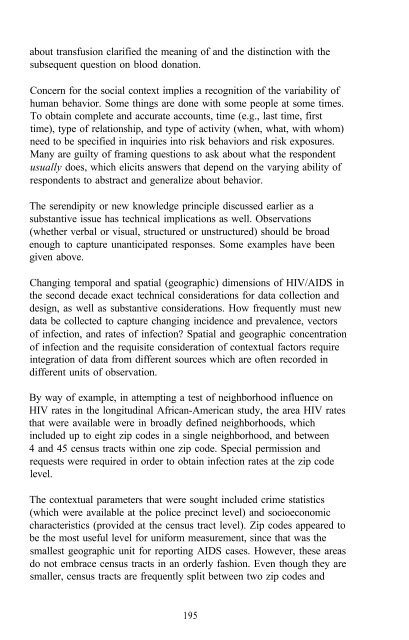The Context of HIV Risk Among Drug Users and Their Sexual Partners
The Context of HIV Risk Among Drug Users and Their Sexual Partners
The Context of HIV Risk Among Drug Users and Their Sexual Partners
Create successful ePaper yourself
Turn your PDF publications into a flip-book with our unique Google optimized e-Paper software.
about transfusion clarified the meaning <strong>of</strong> <strong>and</strong> the distinction with the<br />
subsequent question on blood donation.<br />
Concern for the social context implies a recognition <strong>of</strong> the variability <strong>of</strong><br />
human behavior. Some things are done with some people at some times.<br />
To obtain complete <strong>and</strong> accurate accounts, time (e.g., last time, first<br />
time), type <strong>of</strong> relationship, <strong>and</strong> type <strong>of</strong> activity (when, what, with whom)<br />
need to be specified in inquiries into risk behaviors <strong>and</strong> risk exposures.<br />
Many are guilty <strong>of</strong> framing questions to ask about what the respondent<br />
usually does, which elicits answers that depend on the varying ability <strong>of</strong><br />
respondents to abstract <strong>and</strong> generalize about behavior.<br />
<strong>The</strong> serendipity or new knowledge principle discussed earlier as a<br />
substantive issue has technical implications as well. Observations<br />
(whether verbal or visual, structured or unstructured) should be broad<br />
enough to capture unanticipated responses. Some examples have been<br />
given above.<br />
Changing temporal <strong>and</strong> spatial (geographic) dimensions <strong>of</strong> <strong>HIV</strong>/AIDS in<br />
the second decade exact technical considerations for data collection <strong>and</strong><br />
design, as well as substantive considerations. How frequently must new<br />
data be collected to capture changing incidence <strong>and</strong> prevalence, vectors<br />
<strong>of</strong> infection, <strong>and</strong> rates <strong>of</strong> infection? Spatial <strong>and</strong> geographic concentration<br />
<strong>of</strong> infection <strong>and</strong> the requisite consideration <strong>of</strong> contextual factors require<br />
integration <strong>of</strong> data from different sources which are <strong>of</strong>ten recorded in<br />
different units <strong>of</strong> observation.<br />
By way <strong>of</strong> example, in attempting a test <strong>of</strong> neighborhood influence on<br />
<strong>HIV</strong> rates in the longitudinal African-American study, the area <strong>HIV</strong> rates<br />
that were available were in broadly defined neighborhoods, which<br />
included up to eight zip codes in a single neighborhood, <strong>and</strong> between<br />
4 <strong>and</strong> 45 census tracts within one zip code. Special permission <strong>and</strong><br />
requests were required in order to obtain infection rates at the zip code<br />
level.<br />
<strong>The</strong> contextual parameters that were sought included crime statistics<br />
(which were available at the police precinct level) <strong>and</strong> socioeconomic<br />
characteristics (provided at the census tract level). Zip codes appeared to<br />
be the most useful level for uniform measurement, since that was the<br />
smallest geographic unit for reporting AIDS cases. However, these areas<br />
do not embrace census tracts in an orderly fashion. Even though they are<br />
smaller, census tracts are frequently split between two zip codes <strong>and</strong><br />
195
















